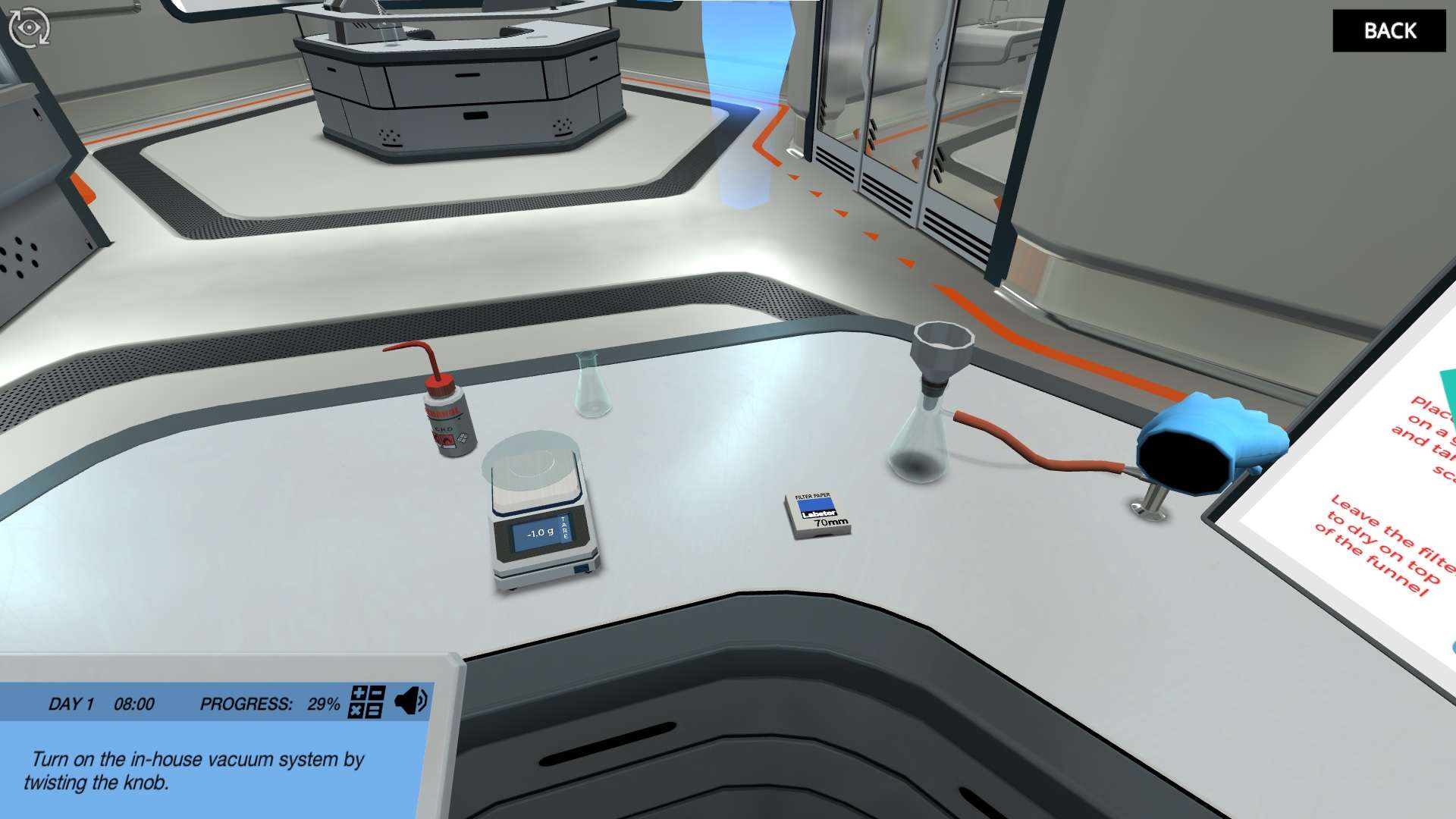Heading 1
Heading 2
Heading 3
Heading 4
Heading 5
Heading 6
Lorem ipsum dolor sit amet, consectetur adipiscing elit, sed do eiusmod tempor incididunt ut labore et dolore magna aliqua. Ut enim ad minim veniam, quis nostrud exercitation ullamco laboris nisi ut aliquip ex ea commodo consequat. Duis aute irure dolor in reprehenderit in voluptate velit esse cillum dolore eu fugiat nulla pariatur.
Block quote
Ordered list
- Item 1
- Item 2
- Item 3
Unordered list
- Item A
- Item B
- Item C
Bold text
Emphasis
Superscript
Subscript
About This Simulation
How can we separate liquids from solids? How can we determine the purity of that solid? In this simulation you will learn how to use the suction filtration and melting point techniques that will allow you to answer both questions.
Learning Objectives
- Explain the fundamentals of recrystallization theory and be able to describe the process on molecular and operational levels
- Carry out the recrystallization technique by following best practices
- Be able to troubleshoot and rectify common problems encountered in recrystallization
About This Simulation
Lab Techniques
- Suction filtration
- Melting point
Related Standards
- Alignment pending
- Alignment pending
- Alignment pending
Learn More About This Simulation
This mini-simulation is part of the larger “Recrystallization: Purify your solid.” See the full version for more information.
How can we separate a solid from a liquid and determine its purity?
In this simulation, you will learn all the steps necessary to separate a solid from a liquid and then determine the purity of that solid.
Filtrate and determine the melting point
Filtrate a solid to separate it from a liquid. Once done, you will be able to determine the solid’s melting point range, which will allow you to determine its purity.
Fast, painless, and repeatable melting points!
The melting point technique uses the reagent in the process, meaning you could run out in a normal laboratory experiment. Luckily, in this virtual simulation you’ll be able to repeat the process as many times as you need—no need to worry about the amount of reagent left!
Understand the big picture and master the individual steps
In this lab, you will be able to understand what we’re trying to achieve from the very beginning. You’ll also have a very detailed protocol to follow, including support images, to help make your experience smooth.
RELATED SIMULATIONS:
Recrystallization: Purify your solid
Recrystallization: Dissolve your solid and precipitate your crystals
For Science Programs Providing a Learning Advantage
Boost STEM Pass Rates
Boost Learning with Fun
75% of students show high engagement and improved grades with Labster
Discover Simulations That Match Your Syllabus
Easily bolster your learning objectives with relevant, interactive content
Place Students in the Shoes of Real Scientists
Practice a lab procedure or visualize theory through narrative-driven scenarios


FAQs
Find answers to frequently asked questions.
Heading 1
Heading 2
Heading 3
Heading 4
Heading 5
Heading 6
Lorem ipsum dolor sit amet, consectetur adipiscing elit, sed do eiusmod tempor incididunt ut labore et dolore magna aliqua. Ut enim ad minim veniam, quis nostrud exercitation ullamco laboris nisi ut aliquip ex ea commodo consequat. Duis aute irure dolor in reprehenderit in voluptate velit esse cillum dolore eu fugiat nulla pariatur.
Block quote
Ordered list
- Item 1
- Item 2
- Item 3
Unordered list
- Item A
- Item B
- Item C
Bold text
Emphasis
Superscript
Subscript
A Labster virtual lab is an interactive, multimedia assignment that students access right from their computers. Many Labster virtual labs prepare students for success in college by introducing foundational knowledge using multimedia visualizations that make it easier to understand complex concepts. Other Labster virtual labs prepare learners for careers in STEM labs by giving them realistic practice on lab techniques and procedures.
Labster’s virtual lab simulations are created by scientists and designed to maximize engagement and interactivity. Unlike watching a video or reading a textbook, Labster virtual labs are interactive. To make progress, students must think critically and solve a real-world problem. We believe that learning by doing makes STEM stick.
Yes, Labster is compatible with all major LMS (Learning Management Systems) including Blackboard, Canvas, D2L, Moodle, and many others. Students can access Labster like any other assignment. If your institution does not choose an LMS integration, students will log into Labster’s Course Manager once they have an account created. Your institution will decide which is the best access method.
Labster is available for purchase by instructors, faculty, and administrators at education institutions. Purchasing our starter package, Labster Explorer, can be done using a credit card if you are located in the USA, Canada, or Mexico. If you are outside of North America or are choosing a higher plan, please speak with a Labster sales representative. Compare plans.
Labster supports a wide range of STEM courses at the high school, college, and university level across fields in biology, chemistry, physics, and health sciences. You can identify topics for your courses by searching our Content Catalog.















